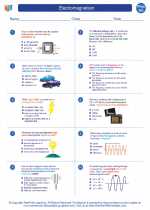Coriolis Effect
The Coriolis Effect is an apparent deflection of moving objects when they are viewed from a rotating frame of reference. It is caused by the rotation of the Earth and is most noticeable in large-scale motions, such as the circulation of the atmosphere and the oceans.
Causes of the Coriolis Effect
The Coriolis Effect is caused by the rotation of the Earth. As the Earth spins on its axis, the speed of rotation varies with latitude. This variation in speed causes moving objects to appear to be deflected to the right in the Northern Hemisphere and to the left in the Southern Hemisphere.
Coriolis Force
When an object moves in a rotating frame of reference, it experiences a force called the Coriolis force. This force is perpendicular to the object's velocity and the axis of rotation of the frame of reference. The Coriolis force can influence the direction of motion of objects such as air masses, ocean currents, and even projectiles.
Effects on Atmospheric and Oceanic Circulation
The Coriolis Effect plays a significant role in shaping the patterns of atmospheric and oceanic circulation. In the atmosphere, it causes the deflection of large-scale air masses, leading to the formation of prevailing winds and global wind patterns. In the oceans, the Coriolis Effect influences the direction of ocean currents, contributing to the creation of major oceanic circulation patterns.
Study Guide
- Explain the concept of the Coriolis Effect and its causes.
- Describe the Coriolis force and its relationship to the movement of objects in a rotating frame of reference.
- Discuss the impact of the Coriolis Effect on atmospheric circulation, including the formation of prevailing winds and global wind patterns.
- Explain how the Coriolis Effect influences oceanic circulation and the formation of major ocean currents.
- Provide real-world examples of the Coriolis Effect in action, such as the deflection of projectiles and the movement of hurricanes.
- Discuss the implications of the Coriolis Effect on global weather patterns and climate systems.
Understanding the Coriolis Effect is crucial for comprehending the dynamics of Earth's atmospheric and oceanic systems. It also has practical applications in fields such as meteorology, oceanography, and navigation.
[Coriolis Effect] Related Worksheets and Study Guides:
.◂Physics Worksheets and Study Guides High School. Electromagnetism

 Worksheet/Answer key
Worksheet/Answer key
 Worksheet/Answer key
Worksheet/Answer key
